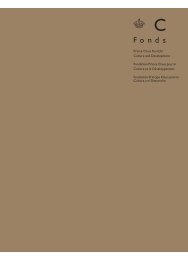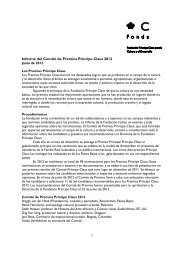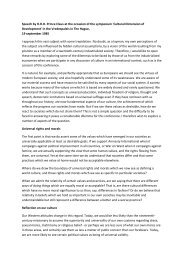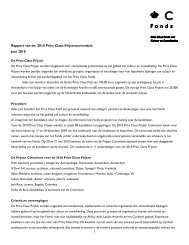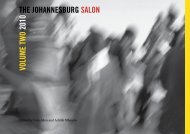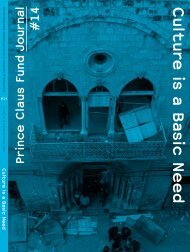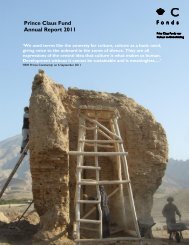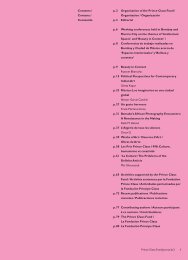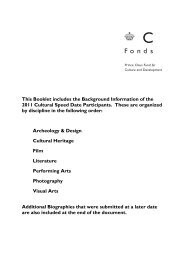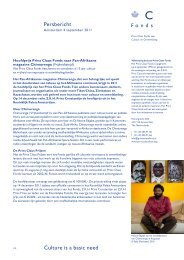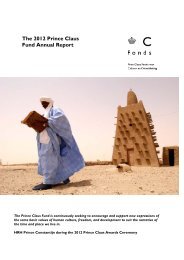3 summer 2011 - Prince Claus Fund
3 summer 2011 - Prince Claus Fund
3 summer 2011 - Prince Claus Fund
- No tags were found...
You also want an ePaper? Increase the reach of your titles
YUMPU automatically turns print PDFs into web optimized ePapers that Google loves.
030–053talattekin_alt:turklergaram 29.11.2007 9:22 Uhr Seite 50tant feature of Khakas: bar > par “present,” basa > paza “anew,”beş > pis “five,” ber- > pir- “to give,” bol- > pol- “to become,”etc.5. Another important feature of Khakas is the regularchange of the postvelar /q/ to the fricative /x/: adaq > azax“foot,” qadıng > xazıng “beech tree,” çıq- > sıx-, qız > xıs “girl,”qol > xol “hand,” yaqşı > çaxsı “good,” etc.6. In Khakas, the initial /ä, e/ changes to /i/, as in Tatarand Bashkir: käl- > kil- “to come,” käs- > kis- “to cut,” beş >pis “five,” ber- > pir- “to give,” etc.7. On the other hand, a long or short primary /i/ isshortened, again as in Tatar and Bashkir: bir > pir “one,” biz >pis, tiş > tis “tooth,” iç- > is- “to drink,” isig > izig “hot,” kişi >kizi, etc.8. The change of the initial /y/ to /ç/, as in Tuva, is oneof the most important features of Khakas: yaqşı > çaxsı “good,”yadağ > çazağ “pedestrian,” yıl > çıl, yügür- > çügür- “to run,”etc.9. The Old Turkic /a€/ and /›€, ig/ are preserved inKhakas, as in Tuva: tağ > dağ, bağ > bağ “strap, belt,” qıdığ >kıdığ “coast,” bilig > bilig “science,” tirig > tirig “alive,” etc.A few sentences in Khakas: Çılığ kün polar tip pis niyiktonanıp algabıs “We wore light clothes because the weather iswarm”; Kün sıxxannang per, pis kilometr irt pargabıs “We’ve coveredfive kilometres since sunrise”; Xacan toğıstı tossar, pis sınıxtırgakilerbis “When we’ve finished work, we’ll come to cleanup”; Sirerge par kilerge mining mam çoğıl “I haven’t time tocome to you”; Min sirerzer tangda kilerbin, neke “Perhaps I’llcome to you tomorrow.”B. The Yellow Uighurs and Their LanguageThe Yellow Uighurs are a Turkic people inhabitingChina’s Kansu Province. According to the 1990 census, theirtotal number amounts to 12,297. The Yellow Uighurs are partiallyMongolianized and speak Mongolian, referring to themselvesin Mongolian as Shira Yugur (“Yellow Uighurs”). TheTurkic-speaking Yellow Uighurs refer to themselves as XaraUighurs (“Black Uighurs”). The Yellow Uighurs are Buddhists.Yellow Uighur, which belongs to the same languagegroup (azak group) as Khakas, has no written form. The mainfeatures of Yellow Uighur are the following:1. In Yellow Uighur, as in Khakas, Old Turkic, /d/changes to /z/: adaq > azak “foot” (Khakas azax), adır- > azır-“to separate,” ädär > ezer “saddle,” bädük > pezik “high,” u:dı-> uzu- “to sleep,” etc.2. In Yellow Uighur, as in Khakas, Old Turkic, the initial/b/ changes to /p/: Old Turkic bar- > par- “to arrive,” OT baş >pas, OT ber- > per- (Khakas pir-), etc.3. In Yellow Uighur, as in Khakas, Old Turkic, /fl/changes to /s/: Old Turkic baş > pas (Khakas pas), OT be:ş >pes “five” (Khak. pis), OT ta:ş > tas “stone” (Khak. tas), etc.4. Unlike Khakas, the initial consonant /y/ is preserved:ya:şıl > yasıl “green” (Khakas çazıl), yer > yer (Khak. çir), yığla-> yiğla- “to cry” (Khak. ılga-), yultuz > yıltus “star” (Khak. çıltıs),yüz > yüs “one hundred” (Khak. çüs), etc.5. Unlike Khakas, Old Turkic /fl/ between vowels is preserved:Old Turkic aşuru > asıru “excessive” (Khakas azıra), OTkişi > kise (Khak. kizi), OT yaşıl > yasıl “green” (Khak. çazıl), etc.50LANGUAGE AND IDENTITYVIII. adak GROUPThe Tuvas and Their LanguageThe term Tuva is derived from the tribal name T’o-pa,which is found in old Chinese sources. The T’o-pas belongedto the Eastern Hun Confederation that founded the T’o-pa Weistate, which endured for two hundred years (fourth to sixthcenturies) in northern China.Today, Tuva is spoken primarily in the Tuva AutonomousRepublic (capital: Kyzyl), part of the Russian Federation.According to the 1989 census, the total number of Tuva speakersin the former Soviet Union amounted to 206,924. There arealso small Tuva communities in northern Mongolia, the BuryatAutonomous Republic of the Russian Federation, and theXinjiang Uighur Autonomous Region in China. The religion ofthe Tuvas is a combination of Tibetan Buddhism (Lamaism) andshamanism. Tuva, together with the closely related Tofa(Karagas) dialect, forms a separate branch of the Turkic languages.The Tuvas refer to themselves as Tıva kiji or Tıva. In scientificliterature, this people is typically referred to as Uryanghay,Soyon, or Soyot. Tuva is a Turkic language that emerged as awritten language after the Soviet revolution. On June 28, 1930,the Latin alphabet was adopted by the government of the TuvaPeople’s Republic. This alphabet continued to be employed until1943. Since then, Tuva has been written in a Cyrillic alphabet.The principal features of Tuva are the following:1. The Old Turkic consonant /d/ is preserved in Tuva:Old Turkic adak “foot”= Tuva adak, OT adığ “bear” = Tuv. adığ,OT udı- “to sleep” = Tuv. udu-, OT bädük “big” = Tuv. bedik“high,” etc.2. Long vowels are shortened, short vowels are gutturalized:a:t “name” > at, but at “horse” > a’t; tü:ş “dream,” buttüş- “to descend” > dü’ş-; kı:z “girl” > kıs, but kıs- > kı’s-, etc.3. The final /z/ changes to /s/: az > as, kız > kıs, biz >pis, tuz > tus, küz > küs “autumn,” etc.4. The /fl/ between two vowels changes to /j/: eşik > ejik“door,” kişi > kiji, beş on > bejen “fifty,” bışur- > bıjır- “to cook,”etc.5. The Old Turkic /i/ is generally preserved in Tuva: tıl >dıl “tongue,” ıt > ıt “dog,” bıt > bıt “flea,” bıç- > bış- “to cut,” etc.Tuva possesses four dialects in addition to Karagas:Central, Western, North-Western, and South-Western. The writtenlanguage is based on the Central dialect. There are nowsome 500 or 600 speakers of the language referred to by SovietTurcologists as Tofalarskiy yazık, an oral Tofa language that maybe regarded as a dialect of Tuva. The Tofas live on the northernslopes of the Sayan Mountains and the upper reaches of theUda and Biryusa Rivers. The Tofas are thought to be TurkicizedSamoyeds. In Tuva, as in Khakas, the initial /y/ changes to /ç/:yaş > çaş “young,” yer > çer, yıl > çıl, yol > çol, etc. A few sentencesin Tuva: Kandığ amıradıp çor siler? “How are you?” Kaşharlığ siler? “How old are you?” Bejen harlığ men “I’m fifty”;Kırgan dep sanatınar eves siler “You aren’t really old”; Çaşkınhungdan kudupkan ışkaş cap tur “It’s raining cats and dogs”;Uluğ hünde çılığ bolur bolza hemele:r bis “If it’s hot on Sunday,we’ll go for a row.” After the Soviet revolution, the Tuvas hadtheir own independent republic named Tannu-Tuva. On October13, 1944, for political reasons unknown to the West, this republicjoined the USSR as the Tuva Autonomous Republic.<strong>Prince</strong> <strong>Claus</strong> <strong>Fund</strong> Reader #1 · Summer <strong>2011</strong> · 60



